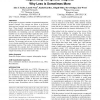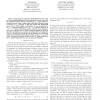310 search results - page 6 / 62 » Why Delannoy numbers |
CVPR
2010
IEEE
14 years 6 months ago
2010
IEEE
Remarkable performance has been reported to recognize single object classes. Scalability to large numbers of classes however remains an important challenge for today's recogn...
WWW
2007
ACM
14 years 10 months ago
2007
ACM
The aggregation and comparison of behavioral patterns on the WWW represent a tremendous opportunity for understanding past behaviors and predicting future behaviors. In this paper...
CP
2009
Springer
14 years 4 months ago
2009
Springer
Abstract. The global cumulative constraint was proposed for modelling cumulative resources in scheduling problems for finite domain (FD) propagation. Since that time a great deal ...
NORDICHI
2006
ACM
14 years 3 months ago
2006
ACM
In this paper we present a number of augmented refrigerator magnet concepts. The concepts are shown to be derived from previous research into the everyday use of fridge surfaces. ...
ISCAS
2005
IEEE
14 years 3 months ago
2005
IEEE
— In this paper we explore the relationship between power and area. By exploiting parallelism (and thus using more area) one can reduce the switching frequency allowing a reducti...


